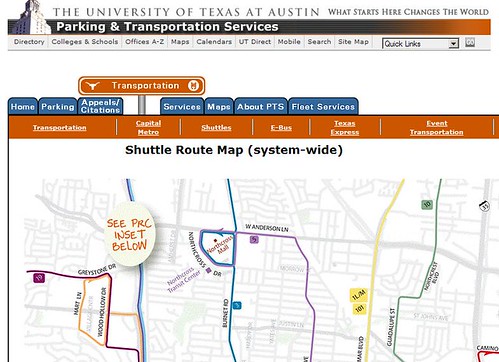
Normally I am quiet on the subject of public transportation since I own a car that I unapologetically drive around town. However, the car that I (now sadly) own is a Toyota Camry and, in light of the recent accelerator sticking problem with many Toyota cars, I decided to stay off the road for a bit. I must add, though I own a car now, I have been happily relying on public transportation during the years that I lived in Taipei and Boston. Even now, if I am in a city where I have the options of driving or riding some kind of convenient public transit, I would gladly choose the latter.
Although many people would say that it is next to impossible to live in the great state of Texas without four wheels, I have observed a few modes of transportation that the people of Austin use to get around town.
1. UT Shuttles
Since I live right next to a UT shuttle stop in West Campus, I must praise the convenience of the shuttles. They are operated by the same company as the MetroBuses, and mostly UT students utilize these shuttles. I just counted on the MetroBuses Web site that there are fourteen shuttle routes that serve to as far as Far West and Lake Austin. The shuttles run fairly frequently during school hours, and I have never waited for more than a few minutes for a shuttle during the day. The only downside is that the shuttles do not operate on Saturdays and with only limited service on Sundays, which makes going to places along the shuttle routes difficult on weekends.
2. MetroBuses
UT shuttle does not take you to where you want to go when you want to go? Fear not! There are still the city buses that have significantly more extensive routes and services. I have only utilized a few lines near campus and downtown when riding the buses was more convenient than driving, but I have seen many commuters taking full advantage of this public good. The best part of the city buses is that anyone with a UT ID (student, faculty and staff) rides for free! There are also the night owl shuttles that run from numerous campus locations to downtown Austin from Thursday to Saturday for the people who are going out on weekend nights. It is definitely a cheap/free alternative to taxis or paying the high parking fees downtown.
3. MetroRail
The MetroRail is something of a novelty in Austin considering that it has not officially started servicing the general public yet. I am on the hopeful lookout to try it once it is in operation, however! The line that will be unveiled first will run north from Downtown to Leander. Another line in the works will run east from downtown Austin. For more information, please visit the MetroRail Web site.
4. Bicycles
I am ashamed to say that I am a terrible biker. I can ride it, but I lack the confidence to ride it anywhere near a busy street when I have to share the road with other wheels (my friend who has ridden with me can vouch for that statement! I am pretty sure she will never ride with me again). But, there are many savvy cyclists in the streets of Austin who safely get from point A to point B without fearful screaming because many streets, especially near and on campus, have bike lanes that make biking so much easier and safer. The City of Austin Web site has a useful resources page on biking in the city.
5. Mopeds/Motorcycles
I own neither of these, but they are pretty awesome! Their ease to park would be, to me, the biggest advantage. There are also parking spots on campus for mopeds and motorcycles if they are your choice modes of transportation.
6. Your own two feet!
Personally, I like nothing more than to walk around town on a nice day, and Austin is known for its nice days! Although your own two feet can only walk so far, they are powerful tools when combined with any above mode of transportation. Most pedestrian paths are paved and comfortable to walk on. You might be surprised with how far you can walk in Austin!
Although nothing beats the convenience of driving your own car, sometimes it is simply easier/cheaper to use one of these alternatives. Plus, you would be reducing your carbon footprint if you decide to use public transportation! I truly believe that the City of Austin is trying its best to become a green and accessible city where people can get around easily without owning a car. I look forward to the arrival of that day!


